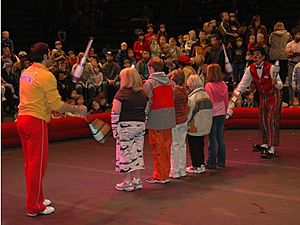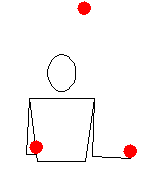Toss juggling facts for kids
Toss juggling is probably what you think of when you hear the word "juggling"! It's when you throw and catch objects in the air. People do toss juggling for fun, as a sport, for exercise, or even as a way to relax.
In toss juggling, you use items like balls, bean bags, rings, or clubs. You toss them up and catch them in a smooth, continuous way. It's a cool skill that involves moving objects around!
Contents
How to Toss Juggling: Basic Moves
Toss juggling has some main rules and patterns. Even the most complex tricks are based on these simple ideas.
What are the Basic Rules?
Most people agree that toss juggling means throwing and catching objects when you have more objects than hands (or other body parts) doing the throwing and catching. For example, if you use three balls with two hands, that's toss juggling! If you only use two balls with two hands, it's not usually called toss juggling because you have the same number of objects and hands.
Main Juggling Patterns
There are three main patterns in toss juggling. Many fancy tricks come from these basic ones.
The Shower
The shower is often shown in pictures of jugglers. In this pattern, the objects go in a circle. One hand throws the objects high, and the other hand passes them back low to the first hand. You can use this pattern for both odd or even numbers of objects.
The Cascade
The cascade is usually the first pattern beginners learn. The objects move in a figure-eight shape. Each hand throws an object to the same height just as the previous throw reaches its highest point. This pattern is best for an odd number of objects, like three balls.
The Fountain
In the fountain pattern, each hand throws and catches its own objects. The objects don't cross over to the other hand. This pattern works best for an even number of objects, like four balls.
Cool Tricks and Advanced Patterns
Beyond the basic cascade, there are many other toss juggling patterns. Some popular ones include the box and columns. There are also tricks where you hold multiple objects in one hand or even make it look like the balls are connected to you!
One very tricky pattern is the Mills Mess. It's famous for how the juggler's hands cross over each other. Jugglers can add cool moves like holds or stalls to make patterns even more exciting.
Other Fun Patterns
Here are a few other common patterns you might see with three balls:
- Burke's Barrage
- Rubenstein's Revenge
- Flash
Juggling as a Performance
Juggling has been a performance skill for thousands of years. Toss juggling is still a big part of shows today! Juggling performances can be about showing off amazing technical skills or making people laugh with comedy. These shows can happen on a stage, as street entertainment, or at events. Often, music or other circus skills are part of the act.
Passing and Sharing Objects
Passing is when two or more jugglers throw objects to each other. A common way is for two jugglers to pass six clubs back and forth, doing different tricks. Jugglers can even pass more objects, with records for passing 13 clubs between two people!
A different way to share objects is called feeding. This is usually done with three or more jugglers. One juggler, called the feeder, throws objects to the other two jugglers, called the feedees, who stand in a triangle shape. They can change how fast they throw and how they pass the objects.
Jugglers are always inventing new passing and feeding patterns. They often practice and share these new ideas at juggling conventions.
Juggling as a Sport
Juggling can also be a sport! Jugglers compete to see who can do the best tricks or performances. There are competitions for single jugglers and for groups. Jason Garfield helped make competitive juggling popular in the USA. He started the World Juggling Federation competition in 2004, which now happens every year.
Juggling for Exercise and Fitness
Juggling is a great way to get exercise. It makes your heart rate go up and helps you breathe faster, just like other aerobic activities. Juggling is also good for improving your hand-eye coordination, physical fitness, and balance.
How Juggling Boosts Your Reflexes
Juggling helps you develop quick reflexes. Jugglers can even develop "higher-order reflexes" that most people don't have. This happens because you repeat the movements over and over. What starts as a difficult skill slowly becomes automatic. As you get better, you can add more complex skills on top of the ones you've mastered. For example, a beginner might struggle to catch a raw egg without breaking it, but a skilled juggler could easily catch one thrown unexpectedly!
Juggling for Relaxation
Even though juggling is great exercise, it can also be very relaxing! When you juggle a repeating pattern, it can help you forget about daily stress. Some jugglers say they feel very calm and focused while juggling. The steady up-and-down movement of the objects and the rhythm can be almost like meditation. When you focus so much on the pattern, your mind can feel like it expands and takes in everything around you.
Juggling for Fun and Friends
Juggling is a fantastic hobby! Besides the health benefits, it's often best when done with friends. The equipment can be cheap or even free, and it's easy to carry around. Juggling is a great way to "break the ice" and start conversations at parties. Jugglers are usually friendly and happy to help beginners. Juggling conventions, clubs, and other gatherings are awesome places to meet people and share the art of juggling. Even people who don't juggle often find themselves trying it out!
In 1990, the International Jugglers' Association guessed that about 23% of Americans could juggle a three-ball cascade.








